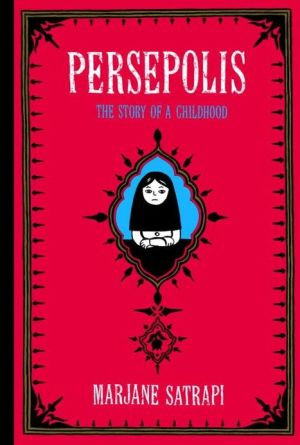Persepolis: The Story of a Childhood
A New York Times Notable Book A Time Magazine “Best Comix of the Year”\ A San Francisco Chronicle and Los Angeles Times Best-seller\ Wise, funny, and heartbreaking, Persepolis is Marjane Satrapi’s memoir of growing up in Iran during the Islamic Revolution. In powerful black-and-white comic strip images, Satrapi tells the story of her life in Tehran from ages six to fourteen, years that saw the overthrow of the Shah’s regime, the triumph of the Islamic Revolution, and the devastating effects...
Search in google:
Originally published to wide critical acclaim in France, where it elicited comparisons to Art Spiegelman's Maus, Persepolis is Marjane Satrapi's wise, funny, and heartbreaking memoir of growing up in Iran during the Islamic Revolution. In powerful black-and-white comic strip images, Satrapi tells the story of her life in Tehran from ages six to fourteen, years that saw the overthrow of the Shah's regime, the triumph of the Islamic Revolution, and the devastating effects of war with Iraq. The intelligent and outspoken only child of committed Marxists and the great-granddaughter of one of Iran's last emperors, Marjane bears witness to a childhood uniquely entwined with the history of her country. Persepolis paints an unforgettable portrait of daily life in Iran: of the bewildering contradictions between home life and public life and of the enormous toll repressive regimes exact on the individual spirit. Marjane's child's-eye-view of dethroned emperors, state-sanctioned whippings, and heroes of the revolution allows us to learn as she does the history of this fascinating country and of her own extraordinary family. Intensely personal, profoundly political, and wholly original, Persepolis is at once a story of growing up and a stunning reminder of the human cost of war and political repression. It shows how we carry on, through laughter and tears, in the face of absurdity. And, finally, it introduces us to an irresistible little girl with whom we cannot help but fall in love.About the Author Marjane Satrapi was born in 1969 in Rasht, Iran. She grew up in Tehran, where she studied at the Lycée Français before leaving for Vienna and then going to Strasbourg to study illustration. She currently lives in Paris, where she is at work on the sequel to Persepolis and where her illustrations appear regularly in newspapers and magazines. She is also the author of several children's books.USA Today… the simple lines and shapes of Satrapi's drawings lend poignancy to the story. The fact that she is able to portray such a vast range of emotions with a few simple strokes of a pen is impressive. That she does this consistently for 153 pages is a mighty achievement. — Christopher Theokas
\ The New York TimesSatrapi's drawing style is bold and vivid. She paints a thick inky black-on-white, in a faux-naif pastiche of East and West. Persepolis deploys all the paranoid Expressionism latent in the comic strip's juxtapositions of scale -- the child dwarfed by looming parents, would-be rescuers dwarfed by giant policemen guarding the locked doors to a movie theater that's been set on fire -- but when Satrapi depicts a schoolyard brawl, it's straight from Persian miniature. Persepolis was first published to enormous success in Satrapi's adopted France, where adult comic books are a long-favored form. The English edition comes with an introduction expressing the author's desire to show Americans that Iran is not only a country of fanatics and terrorists. The book could hardly have come at a better moment. — Fernanda Eberstadt\ \ \ \ \ Liberation (France)A triumph. . . . Like Maus, Persepolis is one of those comic books capable of seducing even those most allergic to the genre. The author's masterstroke is to allow us to experience history from within her family, with irony and tenderness.\ \ \ USA Today… the simple lines and shapes of Satrapi's drawings lend poignancy to the story. The fact that she is able to portray such a vast range of emotions with a few simple strokes of a pen is impressive. That she does this consistently for 153 pages is a mighty achievement. — Christopher Theokas\ \ \ \ \ The New YorkerThe Turkish novelist and translator Güneli Gün grew up on an Aegean island once used to quarantine pilgrims returning from Mecca. In Remembering Childhood in the Middle East: Memoirs From A Century of Change, an anthology edited by Elizabeth Warnock Fernea, Gün recalls her anger at her parents' refusal to love Quarantine Island. Her mother missed cosmopolitan social life; her father, a doctor, ridiculed his staff and railed about " 'the agony of the East,' by which he meant the scientific backwardness he believed Islam had 'brought upon' us."\ \ Amid the jarring disruptions of life in Tehran during the nineteen-eighties, Marjane Satrapi could at least confide in her parents. Her comic-book memoir, Persepolis: The Story of a Childhood, describes her pain at seeing her country descend into fundamentalism and violence. Satrapi was patriotic; she was relieved to see her father cheer when the BBC confirmed that Iranian bombers had hit Baghdad. Later, though, the slogans scrawled on city walls "To die a martyr is to inject blood into the veins of society") made her fearful that the country's turn toward bellicosity was too extreme.\ \ Firoozeh Dumas' family left Iran permanently in 1976, and missed the seismic shifts back home. In Funny In Farsi: A Memoir of Growing Up Iranian In America, Dumas remembers how in 1977 her parents accepted an all-expenses-paid trip to Washington, D.C., to welcome the Shah. Undeterred by a threatening note slipped under their hotel-room door ("Dear Brainwashed Cowards, You are nothing but puppets of the corrupt Shah . . ."), the family finally reassessed the trip after demonstrators attacked Iranians on a lawn near the White House with nail-studded sticks. Their response? To take the first flight back to California. (Kate Taylor)\ \ \ \ \ Publishers WeeklySatrapi's autobiography is a timely and timeless story of a young girl's life under the Islamic Revolution. Descended from the last Emperor of Iran, Satrapi is nine when fundamentalist rebels overthrow the Shah. While Satrapi's radical parents and their community initially welcome the ouster, they soon learn a new brand of totalitarianism is taking over. Satrapi's art is minimal and stark yet often charming and humorous as it depicts the madness around her. She idolizes those who were imprisoned by the Shah, fascinated by their tales of torture, and bonds with her Uncle Anoosh, only to see the new regime imprison and eventually kill him. Thanks to the Iran-Iraq war, neighbors' homes are bombed, playmates are killed and parties are forbidden. Satrapi's parents, who once lived in luxury despite their politics, struggle to educate their daughter. Her father briefly considers fleeing to America, only to realize the price would be too great. "I can become a taxi driver and you a cleaning lady?" he asks his wife. Iron Maiden, Nikes and Michael Jackson become precious symbols of freedom, and eventually Satrapi's rebellious streak puts her in danger, as even educated women are threatened with beatings for improper attire. Despite the grimness, Satrapi never lapses into sensationalism or sentimentality. Skillfully presenting a child's view of war and her own shifting ideals, she also shows quotidian life in Tehran and her family's pride and love for their country despite the tumultuous times. Powerfully understated, this work joins other memoirs-Spiegelman's Maus and Sacco's Safe Area Goradze-that use comics to make the unthinkable familiar. (Aug.) Copyright 2003 Reed Business Information.\ \ \ \ \ KLIATTMarjane Satrapi was nine years old when the Islamic Revolution reintroduced a religious state in Iran. Her life changed dramatically under the new regime. It became obligatory for her to wear the veil, her previously co-ed school was divided into separate schools for boys and girls, and fear began to rule her world whenever she was outside of her home. The only child of outspoken revolutionaries, Marjane found it nearly impossible to comply with the demands that were made by the new government. Her resultant disobedient and eventual violent behavior put her family in danger, and she was sent to live in Europe at the age of 14. Persepolis is an absolutely breathtaking memoir. The b/w illustrations are simple but they eloquently convey Marjane's perceptions and memories of her childhood in Iran. Satrapi's writing style is straightforward, and the story is told in a way that is easily accessible. Although terrorism and war form the basis of Marjane's childhood experience, we learn through her story that the actions of a few extremists do not reflect the attitude of an entire nation. This is presented in a nontraditional format (similar to Maus, by Art Spiegelman); however, its curricular advantages should not be overlooked. It gives the people of Iran a face and a voice through their spokeswoman, Marjane Satrapi, and the humanization of a people who often appear far away and different is a benefit not to be ignored. (An ALA Best Book for YAs.) KLIATT Codes: JSA*—Exceptional book, recommended for junior and senior high school students, advanced students, and adults. 2003, Random House, Pantheon, 153p. illus., Ages 12 to adult. \ —Heather Lisowski\ \ \ \ \ Library JournalThis extraordinary autobiography tells the story of Satrapi's early life as a girl in late 1970s and early 1980s Iran. Through her young eyes, the reader sees the overthrow of the Shah, the Islamic fundamentalist rise to power, and the war with Iraq. Satrapi was a religious girl who grew up in a progressive family and went to a French school; but after the Islamic revolution, she was forced to wear the veil and ended up rejecting God. Under increasing threat from Iraqi bombings and an oppressive government, Satrapi and her family still managed to enjoy forbidden parties, games, and music (such as Iron Maiden). This fueled Satrapi's own adolescent rebellion, which eventually got her into trouble. Satrapi's simple, cartoony, even cute black-and-white art allows for easy identification with the characters and expertly reflects their varying emotions. When first published in France, where Satrapi now lives, this book won several European comics awards-and it's a prime candidate for American award nominations as well. A remarkable, revealing, and sometimes startling account, this is sure to be one of the most important graphic novels of the year. Highly recommended for older teens and adults. [Previewed in Prepub Alert, LJ 2/15/03.] Copyright 2003 Reed Business Information.\ \ \ \ \ School Library JournalAdult/High School-Marji tells of her life in Iran from the age of 10, when the Islamic revolution of 1979 reintroduced a religious state, through the age of 14 when the Iran-Iraq war forced her parents to send her to Europe for safety. This story, told in graphic format with simple, but expressive, black-and-white illustrations, combines the normal rebelliousness of an intelligent adolescent with the horrors of war and totalitarianism. Marji's parents, especially her freethinking mother, modeled a strong belief in freedom and equality, while her French education gave her a strong faith in God. Her Marxist-inclined family initially favored the overthrow of the Shah, but soon realized that the new regime was more restrictive and unfair than the last. The girl's independence, which made her parents both proud and fearful, caused them to send her to Austria. With bold lines and deceptively uncomplicated scenes, Satrapi conveys her story. From it, teens will learn much of the history of this important area and will identify with young Marji and her friends. This is a graphic novel of immense power and importance for Westerners of all ages. It will speak to the same audience as Art Spiegelman's Maus (Pantheon, 1993).-Susan H. Woodcock, Fairfax County Public Library, Chantilly, VA Copyright 2003 Reed Business Information.\ \ \ \ \ Zadie SmithThis is an excellent comic book, that deserves a place with Joe Sacco and even Art Spiegelman. In her bold black and white panels, Satrapi eloquently reasserts the moral bankruptcy of all political dogma and religious conformity; how it bullies, how it murders, and how it may always be ridiculed by individual rebellions of the spirit and the intellect.\ \







